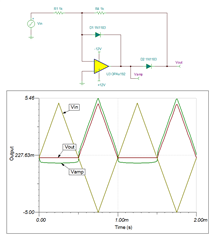Other Parts Discussed in Thread: OPA210, OPA192
Hi everyone,
I'm utilizing a precision full-wave rectifier (www.ti.com/.../tidu030.pdf using OPA1688 and CUS10S40H3F) with post amplification ( non-inverting opamp using OPA210) to measure the amplitude of an AC signal with 300 mVpp to 10 Vpp.
While testing, I observed a drifting output. After investigation I found out that the drift was due to thermal drift in the diodes. Unfortunately the drift is additionly amplified and can't be neglected anymore.
I assume that a peak detector would have the same issue with the thermal drift.
I would appreciate any feedback or suggestions on how to solve this problem.
Best
Hosam





